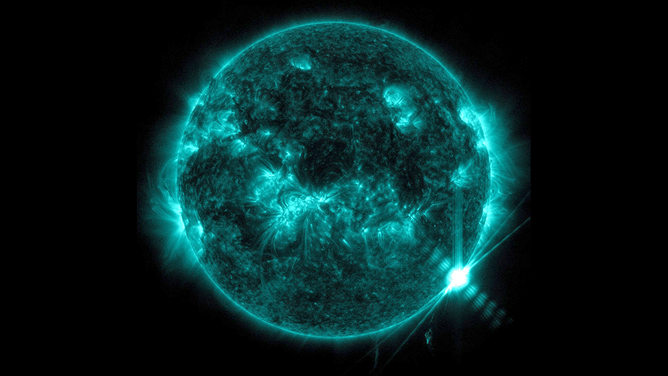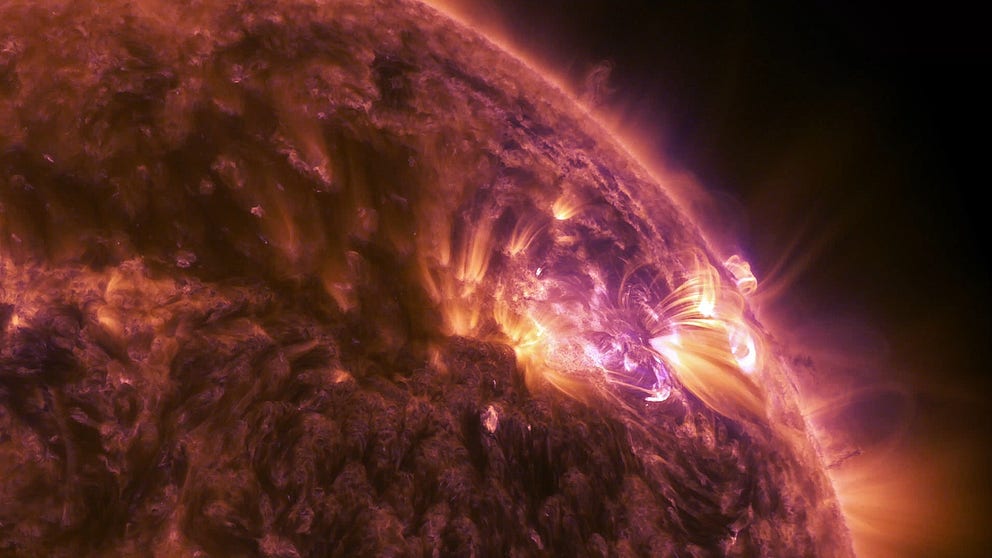Sun blasts strong solar flare causing solar radiation storm, possible radio outages
NASA's Solar Dynamics Observatory captured the powerful X-class solar flare – the rarest type of flare – erupting from the Sun in ultraviolet light. A solar radiation storm could cause communication issues at Earth's poles.
Space weather explained: What is a solar flare?
The largest explosions in the solar system, a solar flare is an explosion of energy that occurs on the sun’s surface, often appearing as a localized burst of bright light.
A strong X-class solar flare was spotted streaming from the Sun on Friday, causing a solar radiation storm on Earth, according to space weather officials with NASA and NOAA.
NOAA's Space Weather Prediction Center (SWPC) said a moderate solar radiation storm (level S2 out of S5) was in progress this weekend after the Sun emitted a strong X-class solar flare on Friday morning, sending charged particles blasting toward Earth. Solar flares are classified according to strength, with the least intense known as B-class, followed by C, M and the most intense, X-class.
According to SWPC, a solar radiation storm happens when charged particles are accelerated near the Sun and arrive at Earth at over 10 times the normal background amount. An S1 event, which is common, began on Friday, and the event was expected to peak at an S2 (moderate) event on Saturday morning. An S2 event is 100 times the normal energetic particles.
GEOMAGNETIC STORM SLAMS INTO EARTH, TRIGGERING VIVID NORTHERN LIGHTS DISPLAY IN NORTHERN US
Powerful solar flares can cause high-frequency radio blackouts in the polar regions and pose risks to space launches and spacecraft orbiting Earth. However, most people do not need to be concerned as these energetic particles do not reach low enough into Earth's atmosphere to affect the public.
SWPC said HF radio signal users on the sunlit side of the planet may have experienced blackouts on Friday when the X-class flare peaked at 8:14 a.m. EST.
NASA's Solar Dynamics Observatory captured the strong solar flare associated with the solar radiation storm. The bright flash of extreme heat can be seen in the lower right of the image.

NASA’s Solar Dynamics Observatory captured this image of a solar flare – as seen in the bright flash on the lower right – on Feb. 9, 2024. The image shows a subset of extreme ultraviolet light that highlights the extremely hot material in flares, and which is colorized in teal. Credit: NASA/SDO
(NASA)
The flare was classified as an X3.3 flare. X is the most intense and rare type of flare, and the number reflects its strength.
This week, NASA said SDO observed 20 M-class flares, the second-most-intense class of flare, and four C-class flares.
Solar flares typically take place in active regions of the Sun, often associated with sunspot groups.
WHAT IS THE 11-YEAR SOLAR CYCLE?
According to NASA, SDO continues to observe a massive sunspot group on the surface of the Sun at the same time as the X-class flare. Sunspots can be viewed with eclipse glasses or a telescope with a solar filter.
More sunspots are expected as the Sun approaches the solar maximum of Solar Cycle 25. In January, more than 120 sunspots were counted on the Sun, according to SWPC data.
